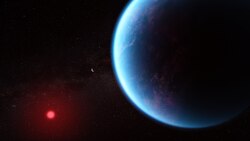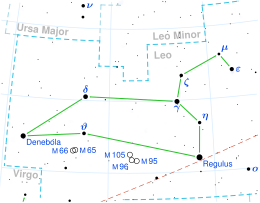Approximate two-dimensional location of the star (in red circle); Sigma Leonis is the nearest bright star, which is in a southerly direction, and the boundary of Virgo is similarly far. | |
| Observation data Epoch J2000.0 Equinox J2000.0 | |
|---|---|
| Constellation | Leo [1] |
| Right ascension | 11h 30m 14.51774s [2] |
| Declination | +07° 35′ 18.2553″ [2] |
| Apparent magnitude (V) | 13.50 [3] |
| Characteristics | |
| Evolutionary stage | Red dwarf |
| Spectral type | M2.8 [4] |
| Astrometry | |
| Radial velocity (Rv) | 0.02±0.52 [2] km/s |
| Proper motion (μ) | RA: −80.479 mas/yr [2] Dec.: −133.007 mas/yr [2] |
| Parallax (π) | 26.2469±0.0266 mas [2] |
| Distance | 124.3 ± 0.1 ly (38.10 ± 0.04 pc) |
| Details | |
| Mass | 0.495±0.004 [5] M☉ |
| Radius | 0.469±0.010 [5] R☉ |
| Luminosity | 0.0234 [6] L☉ |
| Temperature | 3,645±52 [7] K |
| Metallicity [Fe/H] | +0.10±0.12 [7] dex |
| Rotation | 38.9 to 40.2 [7] days |
| Age | 2.9 to 3.1 [7] Gyr |
| Other designations | |
| K2-18, EPIC 201912552, TIC 388804061, 2MASS J11301450+0735180 [8] | |
| Database references | |
| SIMBAD | data |
| Exoplanet Archive | data |
K2-18, also known as EPIC 201912552, is a red dwarf star with two planetary companions located 124 light-years (38 parsecs ) [5] from Earth, in the constellation of Leo.
Contents
Its name is because it was discovered by the K2 Mission, which extended the mission of the Kepler Space Telescope after failure of two of its reaction wheels.

